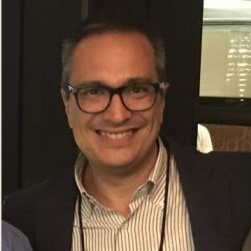In Honor of Giovanni Natile’s 80th Birthday: Metals in Biology and Medicine
A special issue of International Journal of Molecular Sciences (ISSN 1422-0067). This special issue belongs to the section "Biochemistry".
Deadline for manuscript submissions: closed (20 March 2025) | Viewed by 10754
Special Issue Editors
Interests: organometallic and coordination systems; platinum systems; catalysis; bioactive inorganic materials; nanomaterials; magnetic materials; magnetic hyperhermia; hybrid materials; multifunctional polymer composites and nanocomposites
Interests: transition metals (specially platinum) coordination organometallic; bioinorganic chemistry; applications of high field NMR Spectroscopy in the fields of chemistry, biology, pharmaceutical and food sciences
Interests: medicinal inorganic chemistry; organometallic chemistry; metal-based complexes; antitumor platinum drugs; drug delivery of antitumor drugs by inorganic nanocarriers
Special Issues, Collections and Topics in MDPI journals
Special Issue Information
Dear Colleagues,
Giovanni Natile was born in November 1944 in Putignano (Bari, Italy). After graduating in Chemistry in 1968 from the University of Padua, he devoted himself to general and inorganic chemistry as the foundation for a better knowledge of the biochemical and biological processes to be translated in medicinal applications. Chemistry, in this area, has in fact contributed to the understanding of some physiological and pathological processes and to the development of modern pharmacology. Since 1981, he has been a Professor of General and Inorganic Chemistry in the Faculty of Pharmaceutical Sciences at the University of Bari, Italy. As President of the Italian Chemical Society (SCI), Giovanni Natile has worked devotedly to strengthen its editorial policy and to encourage the collaboration with other European chemical societies to improve their partnership and initiated actions to promote the diffusion of chemical knowledge at all levels of society. As European Chemical Society (EuChemS) President (2005-2008), Giovanni Natile chaired its launch event at the European Parliament in 2006, bringing together representatives of the Parliament and the Commission with guests from the key European organizations involved in chemical sciences. With his support, EuCheMS, having signed a declaration on sustainable development, played a prominent role in developing policies, holding meetings in Brussels to publicize reports on energy and sustainable water management. He supported the creation of the European Young Chemists Network and the launch of the European Young Chemist Award. He led EuCheMS in strengthening its links with sister organizations, including the European Chemical Industry Council (CEFIC) and the European Physical Society (EPS). He is Professor Emeritus at the University of Bari.
Giovanni Natile has offered an invaluable contribution to the development and understanding of bioinorganic chemistry of anticancer transition metal organometallic complexes, authoring more than 300 papers. His research activity, which ranges from the first trans-platinum systems with cytotoxic activity, the antitumor activity of Pt(IV) compounds, to the occurrence and overcoming of resistance, metal interference, and the mechanisms of metals’ cellular uptake, has proved the importance of interdisciplinary collaboration in science.
This anniversary Special Issue, entitled “In Honor of Giovanni Natile’s 80th Birthday: Metals in Biology and Medicine”, aims to honor his scientific career by collecting papers concerning the chemistry of metals in biological systems and in medicine, dealing with metalloenzymes and metal-based drugs, retracing the path that, from cisplatin, led to the discovery of new metal compounds in cancer therapy and the understanding of metals’ role in the tumors' development.
Prof. Dr. Roberta Bertani
Prof. Dr. Francesco Paolo Fanizzi
Dr. Nicola Margiotta
Guest Editors
Manuscript Submission Information
Manuscripts should be submitted online at www.mdpi.com by registering and logging in to this website. Once you are registered, click here to go to the submission form. Manuscripts can be submitted until the deadline. All submissions that pass pre-check are peer-reviewed. Accepted papers will be published continuously in the journal (as soon as accepted) and will be listed together on the special issue website. Research articles, review articles as well as short communications are invited. For planned papers, a title and short abstract (about 250 words) can be sent to the Editorial Office for assessment.
Submitted manuscripts should not have been published previously, nor be under consideration for publication elsewhere (except conference proceedings papers). All manuscripts are thoroughly refereed through a single-blind peer-review process. A guide for authors and other relevant information for submission of manuscripts is available on the Instructions for Authors page. International Journal of Molecular Sciences is an international peer-reviewed open access semimonthly journal published by MDPI.
Please visit the Instructions for Authors page before submitting a manuscript. There is an Article Processing Charge (APC) for publication in this open access journal. For details about the APC please see here. Submitted papers should be well formatted and use good English. Authors may use MDPI's English editing service prior to publication or during author revisions.
Benefits of Publishing in a Special Issue
- Ease of navigation: Grouping papers by topic helps scholars navigate broad scope journals more efficiently.
- Greater discoverability: Special Issues support the reach and impact of scientific research. Articles in Special Issues are more discoverable and cited more frequently.
- Expansion of research network: Special Issues facilitate connections among authors, fostering scientific collaborations.
- External promotion: Articles in Special Issues are often promoted through the journal's social media, increasing their visibility.
- Reprint: MDPI Books provides the opportunity to republish successful Special Issues in book format, both online and in print.
Further information on MDPI's Special Issue policies can be found here.








